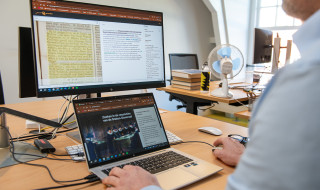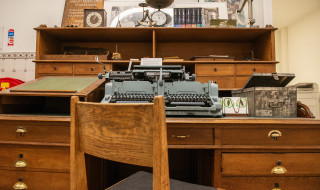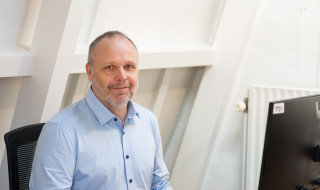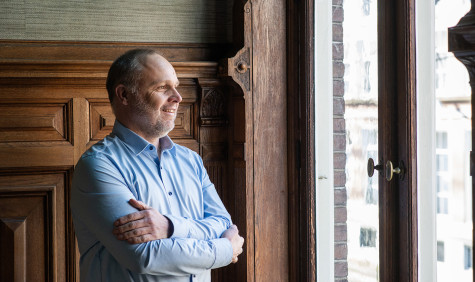"No generic solution makes all researchers happy in one fell swoop."
Menno Rasch, a fan of team science
Heritage. It’s hard to avoid it when you walk along the old Amsterdam canals to the Royal Netherlands Academy of Arts and Sciences (KNAW) historic building. There, we speak with Menno Rasch, director of Digital Infrastructure at the KNAW’s Humanities Cluster. The main topic of conversation? That, not surprisingly, is the digitisation of our national heritage.
“I studied computer science and later philosophy. At first, I thought the two studies didn’t have much to do with each other. Yes, ‘logic’ plays an important role in both, but I didn’t go to study philosophy for logic. Nowadays, I work at the intersection of IT and humanities. That’s how the two studies ended up coming together, after all.”
Wifi and printing
Since 2021, Menno Rasch has been the spider in the digital web of the Humanities Cluster, a partnership between the Meertens Institute, the Huygens Institute and the International Institute of Social History (IISG). Before that, he worked as an information specialist, sector head at the Koninklijke Bibliotheek, sector manager of Innovation and program manager of Research IT at Utrecht University. In the latter position, he was concerned with developing and optimising the research infrastructure.
“I didn’t set up that infrastructure myself, mind you. That would be too much honour. I was closely involved, however. It turned out that not much was arranged for the researcher. There was wifi, you could print and that was about it. When we wanted to delve into the specific needs of researchers, we quickly ran into the diversity of the subject. After all, no generic solution makes all researchers happy in one fell swoop. In the world of education, this is somewhat simpler. Then you opt for Blackboard- or Osiris-like systems that cover a broad support palette. That’s a lot trickier in research.”
From chalkboard to hpc
“All researchers,” Menno continues, “work with data, but the needs and applications are very diverse. Researchers conducting interviews, may have enough to store a set of Word files. Others involve gigantic, complicated data sets. I’m quite often surprised by the wide variety of topics and methodologies."
"Take mathematics, for example. There, you have people who still work with a chalkboard, so to speak, and researchers who need high-performance computing. The trick is to bring all these different users and perspectives together. In Utrecht, for example, there was a Statistics help desk for the social sciences. We have broadened that deployment so that help desk is also available for other disciplines.”
National Archives
We ask Menno Rasch how he adds a personal touch to his Director of Digital Infrastructure role.
“I’m not a techie. At most, I know something about IT, about research and the diversity of the research processes. I try to bring technology and researchers together. Talking about that is not extraordinarily complicated. It requires some people skills and understanding of the challenges in different sciences or faculties.”
"The possibilities of AI are groundbreaking and cause great changes."
When we ask him for an example of what he has been working on recently, a broad smile appears.
“That’s mostly about AI. The possibilities of AI are groundbreaking and cause great changes. Within my department, some brilliant people have built Loghi, a tool for Handwritten Text Recognition (HTR). Simply put, we give the computer a picture of a handwritten text, and it turns it into more readable text. We are now applying that widely. For example, we recently completed the Republic project, in which all documents of the old Dutch national government have been digitised and made searchable on the website Goetgevonden.nl. Where you used to have to go to the National Archives to view documents that were difficult to read, you can now read and search them online. Moreover, many of these texts have been enriched with additional information about, for example, persons, places and organisations involved.”

"Where you used to have to go to the National Archives to view documents that were difficult to read, you can now read and search them online."
World War II
“A similar project with more social impact,” he continues briskly, “is Oorlog voor de Rechter. In this, criminal files from the Centraal Archief Bijzondere Rechtspleging (CABR) immediately after World War II are being digitised and made searchable. We deploy AI for automatic document classification so that a scan is recognised as an official report, a handwritten letter or a court ruling, to name a few. For research, AI offers a world of new possibilities.”
“Politicians are now debating whether limited privacy risks outweigh the greater societal interest. This is an extremely valuable resource for historians that can provide new insights into what happened during and after World War II. This can help society deal with this past. We favour everyone having that same access and being able to read what is recorded in this archive. Our technology makes that possible. However, it is up to the user to be mindful of all the biases, human errors, and coloured information in this resource. The accompanying website helps providing context.”
Monks job
“A third project is Globalise. Nearly five million scans of documents from the VOC archives are being made accessible for research. These are pieces that report on everything that happened in Asia. Much is about trade, but the aggressive power politics of the VOC and themes such as exploitation and slavery are also covered extensively. My department was responsible for transcribing these handwritten documents. Together with colleagues from various institutes in the Humanities Cluster, the UvA and the VU, we train models to mark mentions of persons, places and other entities in the texts and detect descriptions of events (such as ship movements or rebellions). This will soon enable researchers to search specifically in this huge archive and quickly find relevant data.”
"We want to share the data as openly as possible, but that doesn’t mean anyone can download it.”
Nu Menno Rasch toch bezig is, brengt hij direct een plan voor de toekomst in.
“We hebben een voorstel bij NWO ingediend voor een project dat LifeTree-NL heet. Heel kort en simpel gezegd, willen we een grote database bouwen van personen die in Nederland leven en hebben geleefd en waar iets over is opgeslagen. Dat is natuurlijk een monnikenklus. Het moet de eerste stap zijn naar een generieke database van historische personen. We beperken ons niet tot beroemdheden, maar nemen ook personen uit voetnoten op. Dus ook de matroos die in een VOC-archief wordt genoemd en waarvan we willen weten wanneer hij leefde en welke reizen hij heeft gemaakt.”

While Menno Rasch is at it, he immediately adds another interesting project for the future.
“We have submitted a proposal to NWO for a project called LifeTree-NL. Very briefly and simply put; we want to build a large database of people who live and have lived in the Netherlands and have something stored about them. This is, of course, a monk’s job. It should be the first step towards a generic database of historical persons. We do not limit ourselves to celebrities but include persons from the footnotes. So we also will be able to find some sailor mentioned in a VOC archive whose name we want to know, when he lived and what voyages he made.”
Without big tech
There is no way around the next question: where do Menno Rasch’s researchers store these gigantic amounts of data?
“That happens partly at SURF, ourselves and another data centre. We always provide at least three locations. And not all three below sea level, we immediately add. We try to avoid big-tech solutions. We like to be in control. We make clear agreements with SURF or with a party hired by SURF. There must be no doubt about who owns the data. And to whom that data is accessible.”
“The data must be secure. It must not be lost, damaged, or compromised. We don’t always want it to be ‘harboured.’ Our First Name Database is a great example of that. There are commercial parties who would love to have this database. Web shops that make children’s clothing with inscriptions, to name a few. We want to share the data as openly as possible, but that doesn’t mean anyone can download it.”
"I always have ideas and love the research profession. However, a third love has been added: heritage."
Team science
All these different projects are probably not a one man job, we joke.
“Correct!” he laughs. “My department consists of about 35 colleagues, the vast majority of whom are techies: many software developers and some administrators. There are not only colleagues working here with a love of IT, but often also with a soft spot for history, language or culture. Because of this strong connection to the content, I rarely see them leave quickly. Those who do, often go to another university, but certainly not to an insurance company or other commercial organisations. I try to create as much space for individual expertise in the work as possible. Nobody gets enthusiastic if you relegate IT people to implementers, like plumbers who only have to lay pipes. At least not my people. That’s why I’m a big fan of ‘team science’. Put researchers, IT people, data managers and other relevant professionals together. Let them work on an equal basis to create a great product. That usually works well, and it makes everyone happy, too.”
“Meanwhile, I listen to possible frustrations and remove bottlenecks as far as possible. As a manager, you also have to be able to sit on your hands. Managers or directors sometimes tend to be very decisive and like to act quickly. I try to be cautious about that. Often, problems solve themselves if you give the experts the space they need. Then the hierarchical line is not needed at all.”

Innovative clout
How much room does Menno Rasch give his team to innovate? To discover techniques and applications without it having to lead to concrete results right away?
"That's a very good question, because that sometimes creates tensions. We are a project organisation that has to deliver projects. Our hours contribute directly to the project goals, because that's what we receive funding for. Occasionally there is some space between those projects to innovate or try something new. Unfortunately, that does not always work out by a long shot. And never as much as we would actually like. It does happen that colleagues develop exciting, innovative things in their spare time. Of course, that is not what I as a manager am aiming for. However, it does show how committed and enthusiastic employees are. But it is true that I would very much like to have a bit more innovative clout."
Finally, we ask about Menno Rasch's personal motivations.
"I always have ideas and love the research profession. However, a third love has been added: heritage. Since 1 January, I have been chairman of NDE, the Digital Heritage Network. That's a network, supported by the KB national library, the National Archive, Sound & Vision, the New Institute, the Cultural Heritage Agency and the KNAW Humanities Cluster. NDE is a network organisation that helps institutions to best preserve, access and connect their digital heritage to other collections. This is a fun organisation to invest time and attention in, because all these heritage institutions are dealing with the same kind of challenges: Making digital heritage available to researchers and the public."
Text: Edwin Ammerlaan
Photo’s: Vera Duivenvoorden
